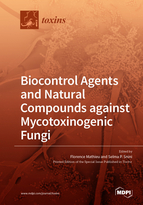Biocontrol Agents and Natural Compounds against Mycotoxinogenic Fungi
A special issue of Toxins (ISSN 2072-6651). This special issue belongs to the section "Mycotoxins".
Deadline for manuscript submissions: closed (31 January 2020) | Viewed by 37576
Special Issue Editors
Special Issues, Collections and Topics in MDPI journals
Special Issues, Collections and Topics in MDPI journals
Special Issue Information
Dear colleagues,
Mycotoxins are fungal secondary metabolites and have deleterious effects on humans, animals, and plants. More than one hundred mycotoxins are known which contaminate food and feed raw materials. Fungal infection and mycotoxin contamination can occur at a pre- or post-harvest stage of production. Given the proven toxicity of mycotoxins and their widespread distribution, it is necessary to develop methods that prevent their occurrence in food and feed. To limit mycotoxin contamination, several techniques could then be adopted either in fields or during storage of harvested goods. These techniques can either directly target fungal development or work to limit mycotoxin levels. Until very recently, phytopharmaceutical products were favored to limit mycotoxin contamination. Nonetheless, the sanitary and environmental impacts of these products and their effects on food quality encourage the development of alternative strategies based on biocontrol agents or natural compounds.
The focus of this Special Issue of Toxins is to gather the most recent advances related to reducing mycotoxin contamination in food and feed using biocontrol agents and natural compounds. In this context, two main types of approaches could be proposed: Preventive methods that could be applied in the field or during storage and acting directly on fungal development and/or on mycotoxin production and curative methods that aim to detoxify contaminated matrices by eliminating the produced mycotoxin. Particular attention will be devoted to deciphering the mode of action of the proposed biocontrol strategies.
Prof. Florence MATHIEU
Dr. Selma P. SNINI
Guest Editors
Manuscript Submission Information
Manuscripts should be submitted online at www.mdpi.com by registering and logging in to this website. Once you are registered, click here to go to the submission form. Manuscripts can be submitted until the deadline. All submissions that pass pre-check are peer-reviewed. Accepted papers will be published continuously in the journal (as soon as accepted) and will be listed together on the special issue website. Research articles, review articles as well as short communications are invited. For planned papers, a title and short abstract (about 100 words) can be sent to the Editorial Office for announcement on this website.
Submitted manuscripts should not have been published previously, nor be under consideration for publication elsewhere (except conference proceedings papers). All manuscripts are thoroughly refereed through a double-blind peer-review process. A guide for authors and other relevant information for submission of manuscripts is available on the Instructions for Authors page. Toxins is an international peer-reviewed open access monthly journal published by MDPI.
Please visit the Instructions for Authors page before submitting a manuscript. The Article Processing Charge (APC) for publication in this open access journal is 2700 CHF (Swiss Francs). Submitted papers should be well formatted and use good English. Authors may use MDPI's English editing service prior to publication or during author revisions.
Keywords
- Mycotoxins
- Mycotoxigenic fungi
- Biocontrol agents
- Natural compounds
- Detoxification
- Microorganisms
- Preventive approaches
- Curative approaches







